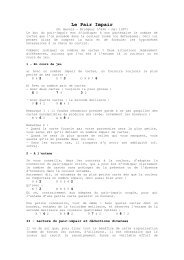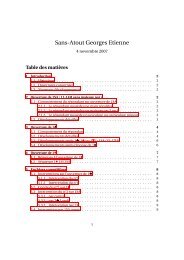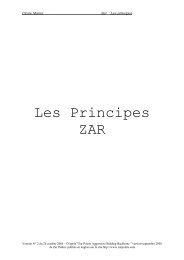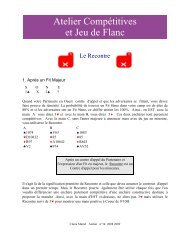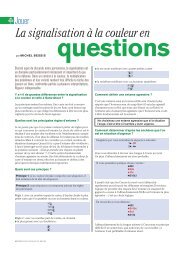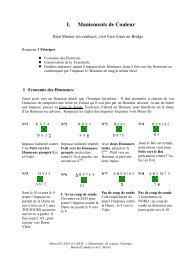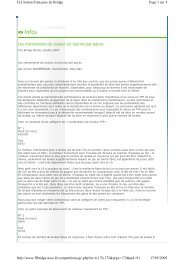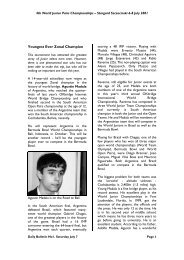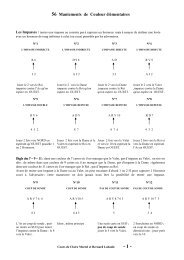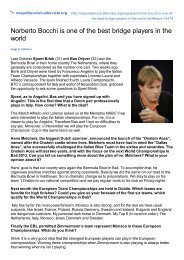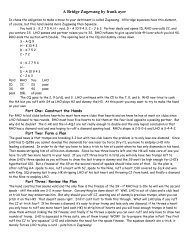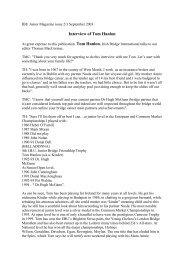Simplified Fantunes â Natural bidding in the 21 century - Claire Bridge
Simplified Fantunes â Natural bidding in the 21 century - Claire Bridge
Simplified Fantunes â Natural bidding in the 21 century - Claire Bridge
Create successful ePaper yourself
Turn your PDF publications into a flip-book with our unique Google optimized e-Paper software.
<strong>Simplified</strong> <strong>Fantunes</strong> – <strong>Natural</strong> <strong>bidd<strong>in</strong>g</strong> <strong>in</strong> <strong>the</strong> <strong>21</strong> st <strong>century</strong><br />
1 Introduction<br />
This article describes a simple version of <strong>the</strong><br />
<strong>Fantunes</strong> system. It is based on <strong>the</strong> system<br />
as played by Italian superstars Fulvio<br />
Fantoni and Claudio Nunes, nicknamed <strong>Fantunes</strong>.<br />
There are also some Polish Club elements<br />
<strong>in</strong>cluded. The system is very flexible<br />
and most of all very natural.<br />
The advantage of <strong>the</strong> <strong>Fantunes</strong> system is experienced<br />
<strong>in</strong> several ways. The extremely<br />
solid 1-bids make both competetive and uncontested<br />
auctions much easier than standard<br />
open<strong>in</strong>g bids because responder can bid more<br />
with less and still control <strong>the</strong> auction. On <strong>the</strong><br />
o<strong>the</strong>r hand, <strong>the</strong> 2-bids are very frequent and<br />
although <strong>the</strong>y preempt <strong>the</strong> auction for us too,<br />
even more so for <strong>the</strong> opponents.<br />
Open<strong>in</strong>g a 1-bid you will categorize your hand<br />
<strong>in</strong> one of <strong>the</strong> follow<strong>in</strong>g strength classes: A<br />
normal hand which is worth about 13 – 17<br />
po<strong>in</strong>ts, a strong hand, worth about 18 – 20<br />
po<strong>in</strong>ts, a semi game forc<strong>in</strong>g hand or a game<br />
force.<br />
Open<strong>in</strong>g bids on <strong>the</strong> 2-level can be approximated<br />
by <strong>the</strong> rule of 18. S<strong>in</strong>ce <strong>the</strong>se bids<br />
are located around <strong>the</strong> average strength of a<br />
bridge hand <strong>the</strong>y are extremely frequent, and<br />
yet <strong>the</strong> range is very small so that partner<br />
will usually have an idea about <strong>the</strong> potential<br />
of <strong>the</strong> hand. However, <strong>the</strong> opponents have<br />
been robbed of valuable <strong>bidd<strong>in</strong>g</strong> space and<br />
examples from <strong>in</strong>ternational play have shown<br />
that even world class opposition have found<br />
it hard to defend aga<strong>in</strong>st <strong>the</strong>se natural bids.<br />
1.1 Open<strong>in</strong>g Bid Structure<br />
The open<strong>in</strong>g bid structure is very natural:<br />
1♣<br />
1♦<br />
1♥<br />
1♠<br />
1NT<br />
2♣<br />
2♦<br />
2♥<br />
2♠<br />
2NT<br />
3suit<br />
13 + 5 + ♣ unb. / 4414 / or 15 + bal.<br />
13 + 4 + ♦ unbal. (4♦5♣ possible)<br />
13 + 5 + ♥<br />
13 + 5 + ♠<br />
12 – 14 (semi)bal., 5422, 5M poss.<br />
9 – 12, 5 + ♣<br />
9 – 12, 5 + ♦<br />
9 – 12, 5 + ♥<br />
9 – 12, 5 + ♠<br />
20 – <strong>21</strong> balanced<br />
<strong>Natural</strong> preempt<br />
The most <strong>in</strong>terest<strong>in</strong>g feature of this system is<br />
that <strong>the</strong> 1-level open<strong>in</strong>g bids are forc<strong>in</strong>g and<br />
unlimited. The m<strong>in</strong>imum required strength<br />
is best described by <strong>the</strong> Rule of 22, i.e. <strong>the</strong><br />
length of <strong>the</strong> two longest suit added to <strong>the</strong><br />
HCP is at least 22. If you prefer Zar evaluation,<br />
<strong>the</strong> m<strong>in</strong>imum open<strong>in</strong>g strength is about<br />
half a level more than a standard m<strong>in</strong>imum<br />
open<strong>in</strong>g bid, i.e. at least 29 Zar. Opposite<br />
a 1-level open<strong>in</strong>g bid a balanced 11-count or<br />
an unbalanced 10-count is usually enough to<br />
force to game.<br />
1.2 Passed hand <strong>bidd<strong>in</strong>g</strong><br />
If partner is a passed hand <strong>the</strong> m<strong>in</strong>imum 1-<br />
level open<strong>in</strong>g strength is <strong>in</strong>creased by one<br />
po<strong>in</strong>t. As even a passed hand might be strong<br />
enough to force to game, <strong>the</strong> response structure<br />
is not changed after <strong>the</strong> 1-level open<strong>in</strong>g<br />
bids.<br />
In 3 rd seat <strong>the</strong> 2-level bids can be very wide<br />
rang<strong>in</strong>g, <strong>in</strong> pr<strong>in</strong>ciple 0 – 13. In 4 th seat <strong>the</strong>se<br />
bids show approximately 10 – 13 HCP.<br />
2 1♣ open<strong>in</strong>g bid<br />
The open<strong>in</strong>g bid 1♣ shows ei<strong>the</strong>r a balanced<br />
hand with at least 15 HCP which may <strong>in</strong>clude<br />
even up to 5 Diamonds, or 5 cards <strong>in</strong> a major<br />
if 15 – 17 HCP, or an unbalanced hand with<br />
4 or more Clubs. 4441-hands with a short<br />
major should be opened 1♦. 1♣ is unlimited<br />
and forc<strong>in</strong>g.<br />
1
2.1 Responses to 1♣<br />
1♦<br />
1♥<br />
1♠<br />
1NT<br />
2♣<br />
2♦<br />
2♥♠<br />
2NT<br />
3♣♦<br />
3♥♠<br />
3NT<br />
0 – 5 any distribution<br />
<strong>in</strong>vitation without 4-card major<br />
6 - 8, both m<strong>in</strong>ors<br />
6 + 4 + ♥, longer m<strong>in</strong>or possible<br />
6 + 4 + ♠, longer m<strong>in</strong>or possible<br />
6 – 8, no 4-card major, not very unbal.<br />
GF, 4 + ♣(4 cards only if bal.)<br />
GF, 4 + ♦(4 cards only if bal.)<br />
4 – 8, 6 + card<br />
Invitational balanced<br />
6 – 8, 6 + card<br />
11 – 13 bal. no stopper <strong>in</strong> o<strong>the</strong>r major<br />
11 – 13 bal. stopper <strong>in</strong> both majors<br />
2.2 After 1♣ – 1♦<br />
The 1♦ response is Polish style as are <strong>the</strong><br />
responses. With a m<strong>in</strong>imum balanced hand<br />
one should rebid <strong>the</strong> longer major, which can<br />
be 3 cards. With stronger hands bid 2♦, <strong>the</strong><br />
strongest response, 2NT unusual or naturally.<br />
1♣ – 1♦ – ?<br />
1♥/♠ <strong>Natural</strong>, 4M only with 18 – 19<br />
1NT 15 – 19 balanced<br />
2♣ 13 – 19, 6 + (5)♣<br />
2♦♥♠ 20 + , natural reverse<br />
2NT 22 – 24, balanced<br />
3♣ Semiforc<strong>in</strong>g, 6 + ♣<br />
3♦ + GF 1-suiter, self-spl<strong>in</strong>ter<br />
1♣ – 1♦ – 1NT – ?<br />
2♣ Both m<strong>in</strong>ors, 6 – 8<br />
2♦ Both majors weak<br />
2♥♠ 5-card suit, weak<br />
2NT Both m<strong>in</strong>ors weak<br />
3♣♦ To play<br />
3♥♠ Ask for stopper <strong>in</strong> this suit<br />
2.3 After 1♣ – 1♥/♠<br />
Responses are natural, except 2♦ which<br />
shows a GF hand with at least 3-card support.<br />
1♣ – 1♥(♠) – ?<br />
1♠<br />
1NT<br />
2♣<br />
2♦<br />
2♥(♠)<br />
2♠(♥)<br />
2NT<br />
3♣<br />
3♦<br />
3♥(♠)<br />
3♠(♥)<br />
3NT<br />
13 + , 4♠ unbalanced, F1R<br />
15 – 18 − balanced no fit<br />
13 – 17, 6(5) + ♣<br />
Odwrotka: GF, 3 + card support<br />
m<strong>in</strong>imum, 3/4-card support<br />
GF unbal. no 3-card support<br />
GF bal. (18 + ) no 4-card support<br />
Invite, 6♣ + 3-card support<br />
GF, 6 + ♣ + 4♦<br />
Invite, 4-card support<br />
GF, 6 + ♣ + 4♠(♥)<br />
Solid ♣ with stoppers<br />
2.3.1 After 1NT rebid<br />
2♦ is to play, 2♣ is Checkback, after which<br />
opener shows his strength and support:<br />
2♦<br />
2M<br />
2oM<br />
2NT<br />
m<strong>in</strong>imum, no 3-card support<br />
m<strong>in</strong>imum, 3-card support<br />
maximum, 3-card support<br />
maximum, no 3-card support<br />
2.3.2 Odwrotka<br />
In <strong>the</strong> sequence 1♣ – 1♥/♠ – 2♦, opener<br />
shows a GF hand and at least 3-card support<br />
of partner’s major. Partner will now bid like<br />
this:<br />
2♥<br />
2♠<br />
2NT<br />
3♣<br />
3♦<br />
3♥<br />
6 – 9, 4 cards<br />
10 + , 4 cards<br />
6 – 9, 5 cards<br />
10 + , 5 cards<br />
6 – 9, 6 + cards<br />
10 + , 6 + cards<br />
2.4 1♣ – 1M – 2o<strong>the</strong>rM<br />
This shows an unbalanced GF hand with less<br />
than 3 cards <strong>in</strong> partner’s major. It also denies<br />
a 6 – 4 distribution or solid ♣. After this responder<br />
will describe his hand without much<br />
extra strength, or ask opener to do so with a<br />
2NT relay, which shows slam <strong>in</strong>terest.<br />
2
3 1♦ open<strong>in</strong>g bid<br />
The open<strong>in</strong>g bid 1♦ shows an unbalanced<br />
hand with at least 4 cards <strong>in</strong> Diamonds. It <strong>in</strong>cludes<br />
4441-hands with any shortness except<br />
♦, and may <strong>in</strong>clude hands with 4♦ 5♣ if <strong>the</strong><br />
♣ suit is bad. 1♦ is unlimited and forc<strong>in</strong>g.<br />
3.1 Responses to 1♦<br />
In contrast to <strong>the</strong> responses to <strong>the</strong> o<strong>the</strong>r open<strong>in</strong>g<br />
bids, <strong>the</strong> responses 2♣/♦ are not forc<strong>in</strong>g<br />
to game but s<strong>in</strong>ce fewer possible f<strong>in</strong>al contracts<br />
have to be considered this is not a problem.<br />
Notice <strong>the</strong> Bergen-style 3♣-response<br />
that covers <strong>the</strong> gap between <strong>the</strong> preemptive<br />
3♦ and <strong>the</strong> <strong>in</strong>verted 2♦.<br />
1♥<br />
1♠<br />
1NT<br />
2♣<br />
2♦<br />
2♥<br />
2♠<br />
2NT<br />
3♣<br />
3♦<br />
3NT<br />
0 + 4 + ♥, longer m<strong>in</strong>or possible<br />
0 + 4 + ♠, longer m<strong>in</strong>or possible<br />
0 – 8, no 4-card major<br />
Inv + , 5(4) + ♣<br />
Inv + , 4 + ♦<br />
Invitational, 6 + ♥<br />
Invitational, 6 + ♠<br />
9 – 10, bal.<br />
6 – 8, 4 + ♦<br />
0 – 5, 5 + ♦<br />
11 – 13 bal.<br />
1♠ 13 – 20, 4♠<br />
1NT 18 + any distribution<br />
2♣ 13 – 17, 5 + 4 + m<strong>in</strong>ors<br />
2♦ 13 – 17, 6(5) + ♦<br />
2♥(♠) 13 – 17, 4(3)-card support<br />
2♠(♥) 18 + , 6 + ♦ 4♠(♥)<br />
2NT 18 – 20, 6♦ and 3-card support<br />
3♣ 15 – 17, 5 – 5<br />
3♦ 15 - 17, 7 + ♦<br />
3♥(♠) 15 – 17, 6♦4♥(♠)<br />
3♠(♥) 6 + ♦– 5 + ♠(♥)<br />
3NT Solid ♣ with stoppers<br />
After <strong>the</strong> 1NT rebid a weak responder can ei<strong>the</strong>r<br />
bid 2♦ which just confirms 0 – 5 HCP<br />
but says noth<strong>in</strong>g about ♦, or rebid his major<br />
naturally. The third option is to rebid<br />
2♥ after show<strong>in</strong>g ♠ with 1♠, this shows 5♠<br />
4♥. Over a weak response opener can force<br />
to game by <strong>bidd<strong>in</strong>g</strong> 2NT.<br />
With enough values to force to game responder<br />
can bid a Checkback-like 2♣ or naturally<br />
higher than 2 of his major.<br />
3.2.1 Responder has a 6-card major<br />
With a 6-card major <strong>in</strong> response to 1♦ and<br />
opener’s rebid, with 0 – 6 HCP rebid your<br />
major. This will be a signoff as partner did<br />
not rebid 1NT. A jump to <strong>the</strong> 3-level is GF.<br />
The <strong>in</strong>between hand would have jumped to<br />
2♥/♠ right away.<br />
3.2 After 1♦ – 1♥/♠<br />
There is a difference here to <strong>the</strong> responses to<br />
1♣ <strong>in</strong> that <strong>the</strong>re is no lower limit to <strong>the</strong> 1♥/♠<br />
responses. However, <strong>the</strong> 1NT rebid has become<br />
free because opener denies a balanced<br />
hand. 1NT now shows any hand worth 18 +<br />
that cannot be bid <strong>in</strong> any o<strong>the</strong>r way.<br />
1♦ – 1♥(♠) – ?<br />
3.3 After 1♦ – 1NT<br />
1NT shows 0 – 8 without a 4-card major<br />
or a suitable hand to raise directly. It may<br />
be passed, which will normally show a nearm<strong>in</strong>imum<br />
hand without 6♦ or 4♣. With 13<br />
– 20 opener will ei<strong>the</strong>r rebid 2♣ or 2♦. With<br />
SemiGF hands opener can choose between 4<br />
natural bids: 2♥, 2♠, 3♣ and 3♦. 2NT is a<br />
general GF hand, 3♥/♠ shows both m<strong>in</strong>ors<br />
and a spl<strong>in</strong>ter <strong>in</strong> <strong>the</strong> bid major.<br />
3
3.4 After 1♦ – 2♣<br />
This sequence is <strong>in</strong>vitational or better, opener<br />
will describe if he is m<strong>in</strong>imum or not. Responder<br />
will always bid 2♦ with a m<strong>in</strong>imum.<br />
3.5 After higher responses<br />
1♦ – 2♦ shows an <strong>in</strong>vitational hand or better<br />
with ♦-support. To show a m<strong>in</strong>imum, opener<br />
bids 3♦.<br />
After <strong>the</strong> <strong>in</strong>vitational jump shifts <strong>in</strong> a major,<br />
2NT is a relay ask<strong>in</strong>g for a feature. O<strong>the</strong>r<br />
bids are natural and GF.<br />
4 1♥/♠ open<strong>in</strong>g bids<br />
The open<strong>in</strong>g bids 1♥ and 1♠ show at least 5<br />
cards <strong>in</strong> <strong>the</strong> bid suit and are unlimited and<br />
forc<strong>in</strong>g. A standard 2/1 GF is used and <strong>the</strong><br />
forc<strong>in</strong>g effect can hardly be noticed. In pr<strong>in</strong>ciple<br />
one should ignore <strong>the</strong> possibility of 0 –<br />
3 HCP for responder. In addition s<strong>in</strong>ce <strong>the</strong><br />
m<strong>in</strong>imum open<strong>in</strong>g strength is a Queen more<br />
than standard, opener should treat his hand<br />
as if it were a Queen weaker, responder as if<br />
it were a Queen stronger.<br />
4.1 Responses to 1♥<br />
1♠<br />
1NT<br />
2♣<br />
2♦<br />
2♥<br />
2♠<br />
2NT<br />
3♣<br />
3♦<br />
3♥<br />
0 + , 4 + ♠, forc<strong>in</strong>g<br />
0 – 10, 3♥ possible, F1R<br />
GF, 5 + ♣ or balanced<br />
GF, 5 + ♦<br />
6 – 8, 3 + ♥<br />
Invitational, 6 + ♠<br />
Jacoby: 12 + , 4 + ♥<br />
Bergen: 9 – 11, 4 + ♥<br />
Bergen: 6 – 8, 4 + ♥<br />
0 – 5, 4 + ♥<br />
4.2 Responses to 1♠<br />
1NT<br />
2♣<br />
2♦<br />
2♦<br />
2♠<br />
2NT<br />
3♣<br />
3♦<br />
3♥<br />
3♠<br />
0 – 10, F1R, 3♠ possible<br />
GF, 5 + ♣ or balanced<br />
GF, 5 + ♦<br />
GF, 5 + ♥<br />
6 – 8, 3 + ♠<br />
Jacoby: 12 + , 4 + ♠<br />
Bergen: 9 – 11, 4 + ♠<br />
Bergen: 6 – 8, 4 + ♠<br />
Invitational, 6 + ♥<br />
0 – 5, 4 + ♠<br />
5 1NT open<strong>in</strong>g bid<br />
Open<strong>in</strong>g 1NT shows 12 – 14 HCP and approximately<br />
balanced. It may <strong>in</strong>clude a 5-card<br />
major, even 5M422 hands. In pr<strong>in</strong>ciple you<br />
can use your favorite 1NT response scheme<br />
after this, for example this one:<br />
2♣<br />
2♦<br />
2♥<br />
2♠<br />
2NT<br />
3♣<br />
3♦<br />
3♥<br />
3♠<br />
3NT<br />
4♣<br />
4♦<br />
4♥<br />
4♠<br />
Stayman<br />
Transfer to ♥<br />
Transfer to ♠<br />
Transfer to ♣<br />
Invitational<br />
Transfer to ♦<br />
Invitational, 6 + ♦<br />
3♥ + Short ♠, GF<br />
3♠ + Short ♥, GF<br />
To play<br />
5 + ♥ 5 + ♠, GF<br />
Transfer to ♥<br />
Transfer to ♠<br />
5 + ♣ 5 + ♦, GF<br />
6 2-level open<strong>in</strong>g bids<br />
The 2-level open<strong>in</strong>g bids are <strong>the</strong> cornerstone<br />
of <strong>the</strong> system. These show approximately 9 –<br />
12 HCP and at least a 5-card suit which need<br />
not be of good quality. Unbalanced hands <strong>in</strong><br />
this range are usually always opened with a<br />
2-bid. This makes <strong>the</strong>m very frequent and<br />
although quite imprecise it puts even more<br />
pressure on <strong>the</strong> opponents.<br />
4
2NT is <strong>the</strong> relay (except after 2♣, where 2♦ is<br />
<strong>the</strong> relay), ask<strong>in</strong>g for m<strong>in</strong>imum or maximum<br />
and distribution. Responder will return to his<br />
suit with a m<strong>in</strong>imum, o<strong>the</strong>r bids are natural.<br />
6.1 Responses to 2♣<br />
2♦ Relay, <strong>in</strong>vite +<br />
2♥ NF, 5 + ♥<br />
2♠ NF, 5 + ♠<br />
2NT Invite to 3NT<br />
3♣ Preemptive<br />
3♦♥♠ Invitational, 6 + card<br />
6.2 Responses to 2♦<br />
2♥ F1R, 4 + ♥<br />
2♠ F1R, 4 + ♠<br />
2NT Relay, <strong>in</strong>vite +<br />
3♣♥♠ Invitational, 6 + card<br />
3♦ Preemptive<br />
6.3 Responses to 2♥<br />
2♠ Forc<strong>in</strong>g, 5 + ♠<br />
2NT Relay, <strong>in</strong>vite +<br />
3♣♦♠ Invitational, 6 + card<br />
3♥ Preemptive<br />
6.4 Responses to 2♠<br />
2NT Relay, <strong>in</strong>vite +<br />
3♣♦ Invite, 6 + card<br />
3♥ GF, 5 + ♥<br />
3♠ Preemptive<br />
6.5 Passed hand <strong>bidd<strong>in</strong>g</strong><br />
In third seat <strong>the</strong> open<strong>in</strong>g bids are very wideranged,<br />
<strong>in</strong> pr<strong>in</strong>ciple 0 – 13 but vulnerable<br />
some values will always be present. The relay<br />
is now only bid on hands that have a fit for<br />
partner. O<strong>the</strong>r bids are <strong>in</strong> pr<strong>in</strong>ciple fit show<strong>in</strong>g<br />
and are ei<strong>the</strong>r natural or lead direct<strong>in</strong>g.<br />
In fourth seat <strong>the</strong> open<strong>in</strong>g bids are more<br />
sound than <strong>in</strong> o<strong>the</strong>r seats, about 10 – 13 HCP.<br />
7 2NT open<strong>in</strong>g bid<br />
This is an agressive strong 2NT open<strong>in</strong>g bid<br />
and should only be used on real balanced<br />
hands, all o<strong>the</strong>r bids are handled by <strong>the</strong> 1-<br />
level open<strong>in</strong>g bids. It denies a 5-card major.<br />
Stayman and Transfers are on, a 3♠ response<br />
shows 5♠ + 4♥ and forc<strong>in</strong>g.<br />
8 After <strong>in</strong>terference<br />
After an overcall or double we no longer have<br />
<strong>the</strong> obligation to respond but we can do so<br />
with quite weak hands, us<strong>in</strong>g <strong>the</strong> fact that<br />
opener must have at least a Queen over a<br />
standard m<strong>in</strong>imum open<strong>in</strong>g bid (even a K<strong>in</strong>g<br />
more if responder is a passed hand).<br />
8.1 Overcalls after 1♣<br />
In pr<strong>in</strong>ciple assume that 1♣ shows a balanced<br />
hand and not a real suit, as this will be <strong>the</strong><br />
case most of <strong>the</strong> time. Unlike after <strong>the</strong> o<strong>the</strong>r<br />
open<strong>in</strong>g bids, <strong>the</strong>re are no fit show<strong>in</strong>g jumps<br />
or fit show<strong>in</strong>g cuebids.<br />
8.2 Overcalls after 1♦♥♠<br />
The general strategy after <strong>the</strong>se natural open<strong>in</strong>g<br />
bids is to show a fit with many possible<br />
bids, Robson - Segal style.<br />
8.2.1 <strong>Natural</strong> overcalls without jump<br />
• 2NT shows an <strong>in</strong>vitational hand with fit<br />
• A bid <strong>in</strong> opponent’s suit shows a GF<br />
hand with fit<br />
• A new suit without jump is forc<strong>in</strong>g<br />
• 1♦ (1♥) 2♠ is a weak jump<br />
• Fit jumps on <strong>the</strong> 3-level and higher<br />
• Lebensohl is on after jump overcalls on<br />
<strong>the</strong> 2-level<br />
5




